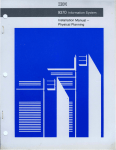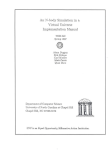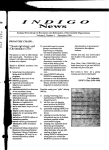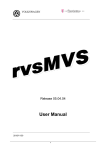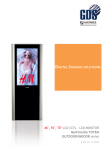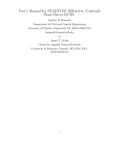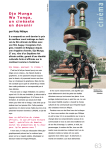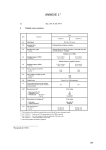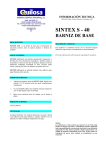Download SAS Macro Library - An Easy Way to Increase the
Transcript
70 Advanced Tutorials SAS Macro Library - An Easy Way to Increase the Productivity and Improve the Quality of SAS Programming LuXu Procter & Gamble Pharmaceuticals, Inc. INTRODUCTION SAS provide tools to support a SAS macro autocalllibrary which can be accessed by any SAS user who bas the access authority. The user can simply invoke the macros in the library from one's progzam ·without· defining them in the progzam. Macros can be shared easily. The productivity of SAS programmers can be increased dramatically. A SAS macro library can be set up in any computer system which supports SAS autocall facility. In the mM MVSrrSO system, Partitioned Data Set (PDS) can be used to support the library; while in the mM eMS system, the MACLm utility can be used to support the library. In the VAX VMS system, source statement directory or a VMS text library can be used to support the library. There are many ways to organize the library: centralized, decentralized or hybrid. No matter what computer system and library organization are used, the library must be reliable, and the macros must be correct. To make a quality product, a good process is essential. To build and maintain a quality SAS macro li&rary a software engineering approach should be adopted. This is because building a library is a group activity, and during the life time of the library there will be multiple versions of the macro code and some personnel changes. The configuration management plan, quality assurance plan and design of the library are the important aspects of the process. A configuration management plan defines all policies related to the project. It provides the methods for managing configuration items during the life time of the project, including the maintenance. A quality assurance plan descnbes the standards and the procedures for the project. Design answers the questions addressed in the requirement of the project in technical detail. NESUG '92 Proceedings This paper discusses some of the issues of building a SAS macro autocalilibrary. CONFIGURATION MANAGEMENT There are two kinds of things that need to be considered: configuration items and policies. Configuration Items For a SAS macro library, there are three types of items that need to be considered: 1. All the documents, including the requirement document, design document, user manual, configuration management plan, some reports, etc. 2. Source Code files. 3. Help library files. Organizations and Policies An organization to manage the project needs to be set up. The responsibility of each job needs to be defined. The process of evaluating and approving or disapproving changes to any project configuration item also needs to be established. AIl the configuration items should be controlled by their corresponding policies. The following are some of the issues which should be addressed by the policy governing the source code file: 1. Current release repository 2. Backups and history There should be a policy to handle an abnormal situation. For example, if fault is discovered in a macro, the macro needs to be taken off the library and the user should be informed by e- Advanced Tutorials mail immediately, also the help library needs to be updated. Procedure for Accepting User Provided Usually two documents are used to process change: This procedure describes the steps to accept a user provided macro. Some necessary steps would be: to complete requirement and design documents, recode according to coding standards, and pass the verification. 1. The new macro request - document filled up by the user to indicate the desire of having a new macro. 71 Macros Code Review Procedure 2. The discrepancy report - document filled up by the user to indicate faults of the existing macro in the library. During the life time of the library, macro code will be updated either because SAS releases its new version or a beUer design and implementation for a macro is introduced. A policy dealing with when the library should be revised and how it should be done is necessary. The key point regarding policy is that policy should be useful, easy to follow and relevant to the project. This procedure describes how code should be reviewed. Use code walk through andlor code inspection techniques. The key point regarding standards and procedures is that overall they should make the job easier. REQUIREMENTS OF THE LmRARY The following are some of the library requirements: Library Security QUALITY ASSURANCE A quality assurance plan describes the standards and the procedures for the project. Some important standards and procedures related to a SAS macro library are: Docwnentation Standards It specifies the format for all documents. A library should be protected against unauthorized and erroneous access which may damage or destroy the library. Information Hiding For each macro defined in the library, only the necessary information for using the macro, (Le., the interface), should be provided to the user, but not the implementation of the macro. Design and Coding Standards Low Coupling It specifies some "should"s and some "should not"s. For example, in coding, all SAS keyword should be in upper case. In design, only the semantics which SAS manual tells explicitly should be used, "short cut" not supported by SAS should not be used. Other Standards If staffs are experienced, a cleanroom software development approach may be used. If so, the cleamoom approach is another standard of the project. Macros should not be coupled with each other or with the macros which a user defines in one's program. No Side Effects Macros should have no side effects. Neither undesired data set change and deletion nor undesired changes of macro variables' value should happen. Consistent with SAS Tradition NESUG '92 Proceedings 72 Advanced Tutorials SAS traditions, such as default data set name, should be followed as much as possible. For example, if no input data set is specified, the most recent data set will be used as the input data set; if no output data set is specified, the output data set will be the same as the input data set. Macro Name The macro name should be meaningful and expandable in a structured manner. DESIGN The following are some of the general design considerations: parameter irrelevant and help user to understand the function of the macro. The Data Set and Macro Variable Created by the Macro Should Be Named in a Special Way In order to eliminate the side effects, the data set and macro variable created by the macro should be named in a special way and let all SAS users who will use the library know this. These names will be reserved. All the data sets created within the macro are temporary which will be deleted at the end of the execution to keep the memory usage at a minimum. Reference Envirorunent and Nested Macro Invocation The Macros Should Be General There are two ways to invoke macros: statement-style and name-style. If combining elements of name-style and statement-style macro invocations in the same call, unexpected results may occur. There are several reasons to use name-style rather than statement-style invocation: In the SAS macro system, symbolic substitution method, which is similar to pass by value parameter passing method, is used for macro variable reference. Reference environment is dynamically determined based on invoking sequence. Macros do not need to be defined in a nested way. If a nest reference is needed, the on!y thing to do is to nest the invocation. Because of the dynamic characteristic, sometime the RUN statement determines the reference environment. See example 1 in the appendix for comparing a nested definition and invocation, and effect of the RUN statement. The general rule is that the RUN statement should always be used for the DATA and PRoe steps. 1. It is easy to identify a name-style invocation inSAS code. The following are some of the specific design considerations: 2. Macros can be invoked anywhere in SAS code by name-style invocation. Library Security For example, a certain operation can be applied on a series of variables, not just one variable, and the variable names do not have to be VARI, VAR2 ..• VARn. Consistent in the Way of Invoking a Macro 3. Statement-style invocation may cause conflict if the macro name and variable are the same. The write authority to the library should only be granted to one person (or account), who usually is the library administrator. The library project member should have the read authority; while the user should only have the execute authority. The Information Needed for Macro Executing Should Be Passed 11u"ough Parameters Low Coupling and No Side Effects Coupling and side effects will be minimized because all parameters are local variables. The keyword parameter passing method should be used, which can incorporate default values of parameters easily, make the order of the The information should be passed by parameters for communication between open SAS code and macro, and between macro and macro. All local variables should be declared local to limit their visibility. NESUG '92 Proceedings Advanced Tutorials 73 %MEND meanby; Consistent with SAS Tradition To be consistent with SAS in handling default data set name, the input data set name of a macro should have a default value of _LAST_, and the output data set name should be determined by the statement: %if %Iength(&dsnout) = 0 %then %Iet dsnout = &dsnin; See example 1 of the appendix. SOME OTHER ISSUES Well-designed test cases are very important to a macro library. Macros must be verified (code review and testing) before being put into the library. The functions of a macro should be limited, otherwise the long and complicated codes will cause difficulties in verification. CONCLUSION To build and maintain a useful SAS macro library is not an easy job, but its reward is tremendous. A software engineering approach is very helpful during the life time of the library. Macro definition B - nested macro definition: %MACRO prtmnbyl(dsnin = _Iast_, byvar =, var =); %MACRO meanby(dsnin = _Iast_, dsnout = , byvar =, var=); %if %length(&dsnout) = 0 %then %181 dsnout = &dsnin; PROC MEANS data = &dsnin noprint; BY &byvar; VAR&var; OUTPUT out = &dsnout; RUN; %MEND meanby; PROC SORT data = &dsnin; BY &byvar; RUN; %meanby(byvar = &byvar, var PROC PRINT data = &dsnin; %MEND prtmnbyl; = &var) SAS code for invoking macro prtmnbyl: Title 'Correct Title'; %prtmnbyl(byvar = group dose time, var ci) Title 'Wrong Title'; APPENDIX Example 1 Macro definition A - nested macro invocation %MACRO prtmnbyl(dsnin = Jast_, byvar =, var =); PROC SORT data = &dsnin; BY &byvar; RUN; %meanby(byvar = &byvar, var = &var) PROC PRINT data = &dsnin; RUN; %MEND prtmnbyl; = %MACRO meanby(dsnin _Iast_, dsnout = , byvar =, var=); %if %length(&dsnout) = 0 %then %let &dsnin; dsnout PROC MEANS data = &dsnin noprint; BY &byvar; = VAR&var; OUTPUT out = &dsnout; RUN; = Macro resolutions for A: PROC SORT DATA = _LAST_; BY GROUP DOSE TIME; RUN; PROC MEANS DATA = _LAST_NOPRINT; BY GROUP DOSE TIME; VARCI; OUTPUT OUT = _LAST_; RUN; PROC PRINT DATA RUN; = _LAST_;. The title for the printout is "Correct Title". Macro resolutions for B: They are the same as those for A except that these is no RUN statement after PROC PRINT, NESUG '92 proceedings 74 Advanced Tutorials which causes the title for the printout to be " Wrong Title" . VM/SP CMS Command Reference Release 6 mM Example 2 The JCL code for adding a macro to the library. II EXEC PGM=IEBUPDTE,PARM=NEW IISYSPRINT DD SYSOUT=A IISYSUT2 DD DSN=PDSname,DISP=MOD IISYSIN DD * .I ADD NAME=membername,UST=ALL %MACRO macroname; Fundamentals of Software Engineering - Carlo Ghezzi Concepts of Programming Languages - Robert W. Sebesta SAS is a registered trademark of SAS Institute Inc. macro code %MEND macroname; .IENDUP mM is a registered trademark of International Business Machines Corporation. 1* Notice that the member name in JCL and the macro name in SAS macro definition should be the same. Example 3 The CMS command MACUB for creating a macro library, adding a member to and deleting a member from the library. 1. Creating a library MACUB GEN libname fn 2. Adding a member to the library MACUB ADD libname fn 3. Deleting a member from the library MACUB DEL Iibname membername libname: file name of a macro hbrary, file type must be MACUB. fn: name of macro definition file, file type must be COPY, file must contain fixed length, 80character records. REFERENCES SAS Language Reference Version 6 First Edition - SAS Institute Inc. SAS Guide to Macro Processing Version 6 Second Edition - SAS Institute Inc. Systeml370 Job Control Language Second Edition - Gary DeWard Brown NESUG '92 Proceedings Comments and information, please contact: LuXu Procter & Gamble Pharmaceuticals Inc. 17 Eaton Ave. Norwich, NY 13815 Tel. (607) 335-2992





